Punjab State Board PSEB 11th Class Maths Book Solutions Chapter 5 Complex Numbers and Quadratic Equations Miscellaneous Exercise Questions and Answers.
PSEB Solutions for Class 11 Maths Chapter 5 Complex Numbers and Quadratic Equations Miscellaneous Exercise
Question 1.
Evaluate \(\left[i^{18}+\left(\frac{1}{i}\right)^{25}\right]^{3}\).
Answer.
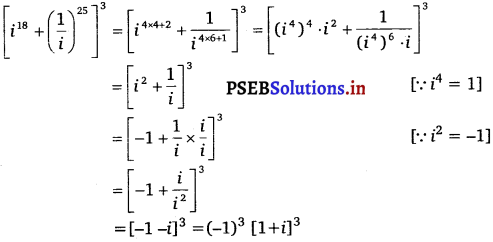
= – [13 + i3 + 3 . 1 – i (1 + i)]
= – [1 + i3 + 3i + 3i2]
= – [1 – i + 3i – 3]
= – [- 2 + 2i]
=2 – 2 i.
![]()
Question 2.
For any two complex numbers z1 and z2, prove that Re (z1z2) = Re z1 Re z2 – Im z1 Im z2.
Answer.
Let z1 = x1 + iy1 and
z2 = x2 + iy2
∴ z1z2 = (x1 + iy1) (x2 + iy2)
= x1 (x2 + iy2) + iy1 (x2 + iy2)
= x1x2 + ix1y2 + iy1x2 + i2y1y2
= x1x2 + ix1y2 + iy1x2 – y1y2 [∵ i2 = – 1]
= (x1x2 – y1y2) + i(x1y2 + y1x2)
Re (z1z2) = x1x2 – y1y2
Re (z1z2) = Re z1 Re z2 – Im z1 Im z2
Hence proved.
Question 3.
Reduce \(\left(\frac{1}{1-4 i}-\frac{2}{1+i}\right)\left(\frac{3-4 i}{5+i}\right)\) to the standard form.
Answer.
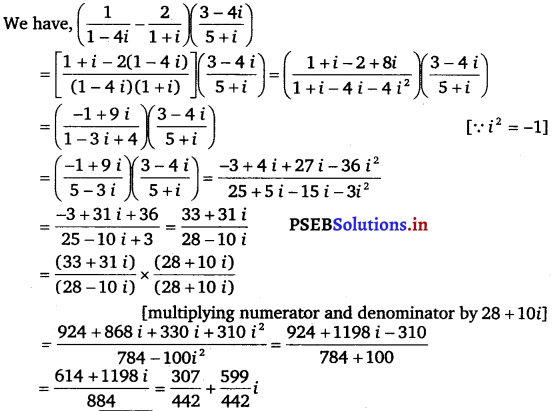
![]()
Question 4.
If x – iy = \(\sqrt{\frac{a-i b}{c-i d}}\) prove that (x2 + y2)2 = \(\frac{a^{2}+b^{2}}{c^{2}+d^{2}}\).
Answer.
We have, x – iy = \(\sqrt{\frac{a-i b}{c-i d}}\)
On squaring both sides, we get
x2 – y2 – 2 ixy = \(\frac{a-i b}{c-i d}\)
= \(\frac{a-i b}{c-i d} \times \frac{c+i d}{c+i d}\) [multiplying numerator and denominator by c + id]
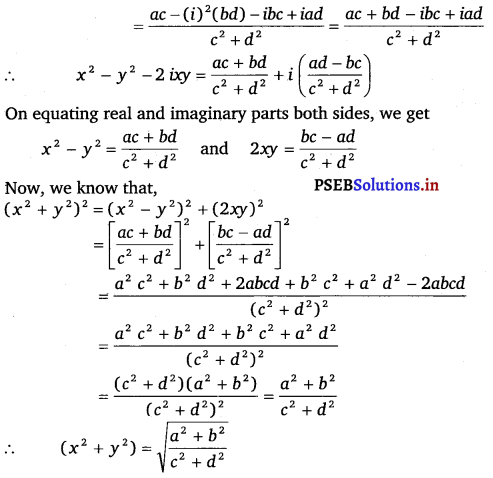
![]()
Question 5.
Convert the following in the polar form.
(i) \(\frac{1+7 i}{(2-i)^{2}}\)
(ii) \(\frac{1+3 i}{1-2 i}\)
Answer.
z = \(\frac{1+7 i}{(2-i)^{2}}\)
(i) Here,
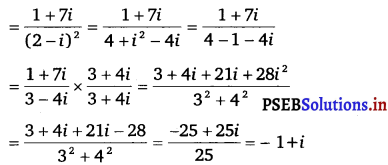
Let r cos θ = 1 and r sin θ = 1
On squaring and adding, we obtain
r2 (cos2 θ + sin2 θ) = 1 + 1
r2 (cos2 θ + sin2 θ) = 2
[∵ cos2 θ + sin2 θ = 1]
r2 = 2 [Conventionally, r > 0]
r = √2
√2 cos θ = – 1 and sin θ = 1
cos θ = \(\frac{-1}{\sqrt{2}}\) and sin θ = \(\frac{1}{\sqrt{2}}\)
∴ θ = π – \(\frac{\pi}{4}\) [As θ lies in II quadrant]
= \(\frac{3 \pi}{4}\)
∴ z = r cos θ + i r sin θ
⇒ \(\sqrt{2} \cos \frac{3 \pi}{4}+i \sqrt{2} \sin \frac{3 \pi}{4}=\sqrt{2}\left(\cos \frac{3 \pi}{4}+i \sin \frac{3 \pi}{4}\right)\)
This is the required polar form.
(ii) 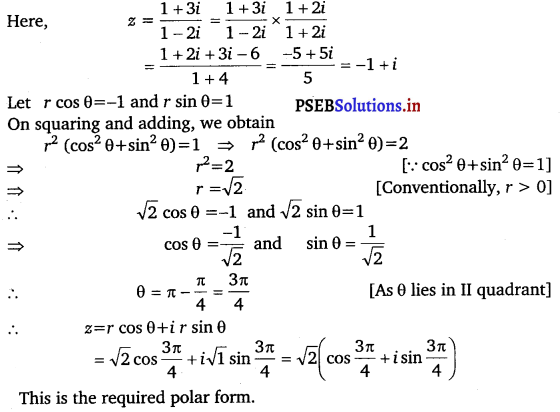
![]()
Question 6.
Solve the equation 3x2 – 4x + \(\frac{20}{3}\) = 0.
Ans.
The given quadratic equation is 3x2 – 4x + \(\frac{20}{3}\) = 0
This equation can also be written as 9x2 – 12x + 20 = 0
On comparing this equation with ax2 + bx + c = 0, we obtain
a = 9, b = – 12, and c = 20
Therefore, the discriminant of the given equation is
D = b2 – 4aç
= (- 12)2 – 4 × 9 × 20
= 144 – 720 = – 576
Therefor, the required solutions are
\(\frac{-b \pm \sqrt{D}}{2 a}=\frac{-(-12) \pm \sqrt{-576}}{2 \times 9}=\frac{12 \pm \sqrt{576} i}{18}\) [∵ √- 1 = i]
= \(\frac{12 \pm 24 i}{18}=\frac{6(2 \pm 4 i)}{18}\)
= \(\frac{2 \pm 4 i}{3}=\frac{2}{3} \pm \frac{4}{3} i\)
Question 7.
Solve the equation x2 – 2x + \(\frac{3}{2}\) = 0
Ans.
The given quadratic equation is x2 – 2x + \(\frac{3}{2}\) = 0
This equation can also be written as 2x2 – 4x + 3 = 0
On comparing this equation with ax2 + bx + c = 0, we obtain
a = 2, b = – 4, and c = 3
Therefore, the discriminant of the given equation is
D = b2 – 4ac
= (- 4)2 – 4 × 2 × 3
= 16 – 24 = -8
Therefore, the required solutions are
\(\frac{-b \pm \sqrt{D}}{2 a}=\frac{-(-4) \pm \sqrt{-8}}{2 \times 2}=\frac{4 \pm 2 \sqrt{2} i}{4}\) [∵ √- 1 = i]
= \(\frac{2 \pm \sqrt{2} i}{2}=1 \pm \frac{\sqrt{2}}{2} i\).
![]()
Question 8.
Solve the equation 27x2 – 10x + 1 = 0
Answer.
The given quadratic equation is 27x2 – 10x + 1 = 0
On comparing the given equation with ax2 + bx + c = 0, we obtain
a = 27, b = – 10, and c = 1
Therefore, the discriminant of the given equation is
D = b2 – 4ac
= (- 10)2 – 4 × 27 × 1
= 100 – 108
= – 8
Therefore, the required solutions are
\(\frac{-b \pm \sqrt{D}}{2 a}=\frac{-(-10) \pm \sqrt{-8}}{2 \times 27}=\frac{10 \pm 2 \sqrt{2} i}{54}\) [∵ √- 1 = i]
= \(\frac{5 \pm \sqrt{2} i}{27}=\frac{5}{27} \pm \frac{\sqrt{2}}{27} i[/latex ]
Question 9.
Solve the equation 21x2 – 28x + 10 = 0
Answer.
The given quadratic equation is 21x2 – 28x + 10 = 0
On comparing the given equation with ax2 + bx + c = 0, we obtain
a = 21, b = – 28, and c = 10 .
Therefore, the discriminant of the given equation is
D = b2 – 4ac
= (- 28)2 – 4 × 21 × 10
= 784 – 840 = – 56
Therefore, the required solutions are
[latex]\frac{-b \pm \sqrt{D}}{2 a}\) = \(\frac{-(-28) \pm \sqrt{-56}}{2 \times 21}\)
= \(\frac{28 \pm \sqrt{56} i}{42}\)
= \(\frac{28 \pm 2 \sqrt{14} i}{42}=\frac{28}{42} \pm \frac{2 \sqrt{14}}{42} i=\frac{2}{3} \pm \frac{\sqrt{14}}{21} i\).
![]()
Question 10.
If z1 = 2 – i, z2 = 1 + i, find \(\left|\frac{z_{1}+z_{2}+1}{z_{1}-z_{2}+1}\right|\).
Answer.

= \(\left|\frac{2(1+i)}{2}\right|\) = |1 + i|
= \(\sqrt{1^{2}+1^{2}}=\sqrt{2}\)
Thus the value of \(\left|\frac{z_{1}+z_{2}+1}{z_{1}-z_{2}+1}\right|\) is √2.
Question 11.
If a + ib = \(\frac{(x+i)^{2}}{2 x^{2}+1}\), prove that a2 + b2 = \(\frac{(x+1)^{2}}{(2 x+1)^{2}}\).
Answer.

![]()
Question 12.
Let z1 = 2 – i1, z2 = – 2 + i
(i) Re (\(\frac{\boldsymbol{z}_{\mathbf{1}} \boldsymbol{z}_{\mathbf{2}}}{\overline{\boldsymbol{z}}_{\mathbf{1}}}\))
(ii) Im (\(\frac{1}{z_{1} \overline{\boldsymbol{z}}_{1}}\))
Answer.
z1 = 2 – i, z2 = – 2 + i,
(i) z1z2 = (2 – i) (- 2 + i)
= – 4 + 2i + 2i – i2
= – 4 + 4i – (- 1)
= – 3 + 4 i
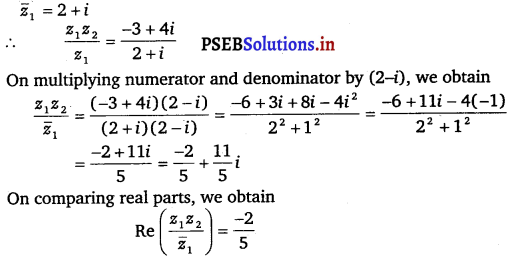
(ii) 
Question 13.
Find the modulus and argument of the complex number
Answer.

![]()
Question 14.
Find the real numbers x and y if (x – iy) (3 + 5i) is the conjugate of – 6 – 24i.
Answer.
We have, (x – iy)(3 + 5i) is the conjugate of – 6 – 24 i
⇒ (x – iy)(3 + 5i) = – 6 – 24i
[conjugate of – 6 – 24i = -6 + 24i]
⇒ 3x – 3iy + 5ix + 5y = – 6 + 24i
(3x + 5y) + i (5x – 3y ) = – 6 + 24i ………………(i)
On equating real and imaginary parts both sides of eq. (i), we get
3x + 5y = – 6 …………….(ii)
and 5x-3y = 24 …………..(iii)
On solving eqs. (ii) and (iii), we get
x = 3 and y = – 3.
Question 15.
Find the modulus of \(\frac{1+i}{1-i}\) – \(\frac{1-i}{1+i}\).
Answer.
\(\frac{1+i}{1-i}-\frac{1-i}{1+i}=\frac{(1+i)^{2}-(1-i)^{2}}{(1-i)(1+i)}\)
= \(\frac{1+i^{2}+2 i-1-i^{2}+2 i}{1^{2}+1}=\frac{4 i}{2}=2 i\)
∴ \(\left|\frac{1+i}{1-i}-\frac{1-i}{1+i}\right|=|2 i|=\sqrt{2^{2}}=2\).
![]()
Question 16.
If (x + iy)3 = u + iv, then show that \(\frac{u}{x}+\frac{v}{y}\) = 4 (x2 – y2).
Answer.
(x + iy)3 = u + iv
x3 + (iy)3 + 3.x.iy (x + iy) = u + iv
= x3 + i3y3 + 3x2yi – 3xy2i2 = u + iv
= x3 – iy3 + 3x2yi – 3xy2 = u + iv
(x3 – 3xy2) + i(3x2y – y3) = u + iv
On equating real and imaginary parts, we obtain
u = x3 – 3xy2, v = 3x2y – y3
∴ \(\frac{u}{x}+\frac{v}{y}=\frac{x^{3}-3 x y^{2}}{x}+\frac{3 x^{2} y-y^{3}}{y}\)
= \(\frac{x\left(x^{2}-3 y^{2}\right)}{x}+\frac{y\left(3 x^{2}-y^{2}\right)}{y}\)
= x2 – 3y2 + 3x2 – y2
= 4x2 – 4y2
= 4 (x2 – y2)
∴ \(\frac{u}{x}+\frac{v}{y}\) = 4 (x2 – y2).
Hence proved.
Question 17.
If α and β are different complex numbers with |β| = 1, then find \(\left|\frac{\beta-\alpha}{1-\bar{\alpha} \beta}\right|\).
Answer.
Let α = a + ib and β = x + iy
It is given that, |β| = 1
∴ \(\sqrt{x^{2}+y^{2}}\) = 1
∴ x2 + y2 = 1 ……………..(i)
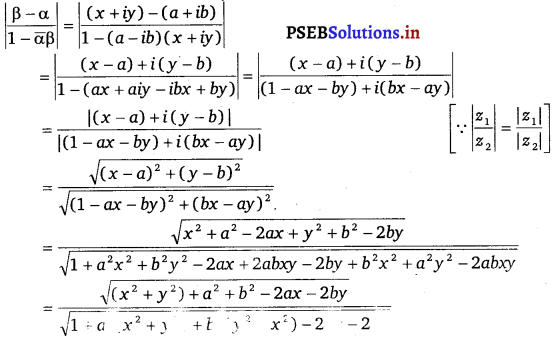
= \(\frac{\sqrt{1+a^{2}+b^{2}-2 a x-2 b y}}{\sqrt{1+a^{2}+b^{2}-2 a x-2 b y}}\) [using eq. (i)]
= 1
∴ \(\left|\frac{\beta-\alpha}{1-\bar{\alpha} \beta}\right|\) = 1.
![]()
Question 18.
Find the number of non-zero integral solutions of the equation |1 – i|x = 2x.
Answer.
|1 – i|x = 2x
⇒ \(\left(\sqrt{1^{2}+(-1)^{2}}\right)^{x}\) = 2x
⇒ (A/2)x = 2x
⇒ 2\(\frac{x}{2}\) = 2x
⇒ \(\frac{x}{2}\) = x
⇒ x = 2x
⇒ 2x – x = 0
⇒ x = 0
Thus, 0 is the only integral solution of the given equation. Therefore, the number of non-zero integral solutions of the given equation is 0.
Question 19.
If (a + ib) (c + id) (e + if) (g + ih) = A + iB, then show that (a2 + b2) (c2 + d2) (e2 + f2) (g2 + h2) = A2 + B2.
Answer.
(a + ib) (c + id) (e + if) (g + ih) = A + iB
∴ |(a + ib)(c + id)(e + if)(g + ih)| = |A + iB|
⇒ |(a + ib)| × |(c + id)| × |(e + if)| × |(g + ih)| = |A + iB| [v |z1z2|=|z1||z2|]
⇒ \(\sqrt{a^{2}+b^{2}} \times \sqrt{c^{2}+d^{2}} \times \sqrt{e^{2}+f^{2}} \times \sqrt{g^{2}+h^{2}}=\sqrt{A^{2}+B^{2}}\)
On squaring both sides, we obtain
(a2 + b2) (c2 + d2) (e2 + f2) (g2 + h2) = A2 + B2
Hence proved.
![]()
Question 20.
If \(\left(\frac{1+i}{1-i}\right)^{m}\) = 1, then find the least positive integral value of m.
Solution.
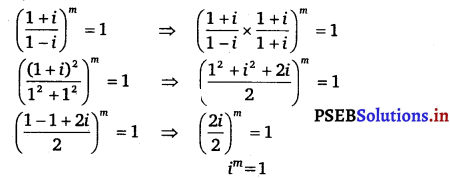
∴ m = 4k, where k is some integer.
Therefore, the least positive integer is 1.
Thus, the least positive integral value of m is 4 (= 4 × 1).
